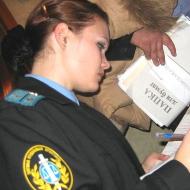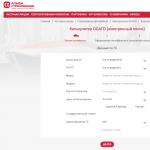
Accounting for beginners: from wiring to balance. Accounting. Types of economic operations in accounting with examples
The duty to fix all the ongoing business operations lies on the shoulders from many legal entities and individual entrepreneurs. According to russian legislation economic subjects There should be constantly accounting, unless otherwise provided for by the Federal Law N 402 "On Accounting" dated December 6, 2011.
Accounting wiring can be considered the cornerstone of accounting, with the help of which any action of the company (buying materials, salary issuing, etc.) is reflected in numbers - that is, the fact of changes in the state of the objects taken into account is recorded. Let's discuss how typical accounting wiring, and consider examples.
What is an accounting account?
Beginner accountants deal with the preparation of wiring without a clear understanding that such an account is very difficult, therefore it is better to move "from the stove."
Accounting account - A certain position in economic accounting required to continuously monitor the motion of the property owned by the company, as well as sources of its education. This is done by using a double recording method, when one operation is reflected twice - on the debit of one account and on the credit of another. All accounts that are used in the accounting of commercial companies are systematized and grouped in a special document plan.
Tip: Analyzing the operation and making the wiring, best to keep at hand overall plan accounting accounts financial economic activity organizations.
Accounting accounts are divided into three types depending on which object is subject to account:
- Active - Designed to display information about the organization and resources available in monetary terms. For example, materials (10), cash in the cashier (50), finished products (43), etc. The initial balance of active accounts is recorded only on the debit, the ultimate is similar. Operations that are characterized by an increase in the company's funds are indicated by the debit of the account. If resources are reduced, the record is on credit.
- Passive - On them in monetary terms, the state, movement and changes of sources are taken into account, at the expense of which the company's economic funds were formed. For example, the amortization of OS (02), a trade markal (42), authorized capital (80), etc. Primary I. eltimate balance Can only be a loan. Records increasing the bill go on credit that reduce - in debit.
- Active passive - Covar bills playing the role and passive, and active. It is important to understand the sign of which account is triggered in each specific situation. The initial balance can record both the debit and loan; Perhaps debit and credit element balance at the same time. For example, an active-passive account 76 "Calculations with different debtors and creditors". If the company has receivables (That is, someone must her), then the amount is written into the debit, and in the case of accounts payable (someone should) - the figure is reflected in the loan.
When accountants were forced to conduct calculations without the use of a computer, the accounts were drawn in the form of peculiar tablets, which in common people are called "airplanes". Each account has its own scheme, they look like this.
- Typical active account diagram:
- Typical Passive Account Scheme:

- Typical scheme of active-passive account:

How are accounting wiring are made?
Accounting wiring is based on the dual record principle: the amount of the operation is recorded by the debit of one account and the credit of the other, that is, the balance is always performed, which is why the asset must always be equal to the liability.
Example: Suppose the founder of LLC made its contribution to the authorized capital in the amount of 10,000 rubles, putting money to the current account. Then you can draw the following conclusion - the company has assets (cash), and at the same time there were commitments to the founder. The result will be the result double recording: Dt 51 "Settlement account" - CT 80 "Authorized capital" - 10,000 rubles.
The meaning and essence of the wiring is easy to understand if you realize - nothing in this world does not arise from nowhere and does not disappear without a trace. Everything is logical - bought materials, it means that money paid for them. In other words, the materials arrived in the materials, and in finance - loss. There is an interesting point here: the movement between articles can occur without a change in the asset and liability. For example, the production of goods was completed, therefore, they switched to the discharge of finished products. Two active accounts were raised - one decreased, and the other increased the same amount. Wiring in such a situation: Dt 43 " Finished products"- CT 20" Basic Production ".
And if the company pays debt to the supplier from the current account, it will occur simultaneous reduction in asset and liabilities, since this operation affects the active account money And actively passive (a sign of passive, as there should be our company) account reflecting accounts debt. Wiring: Dt 60 "Calculations with suppliers and contractors" - CT 51 "Settlement account".
Accounting wiring for specific economic operations
The number of balance sheets is selected to a hundred - of course, it is a lot, especially if you remember that some have numerous subaccounts. Such a variety leads to difficulties: typical accounting wiring There is a great set - only imagine all sorts of combinations. And you need to keep in mind that some operations are recorded not alone, but by several wiring. It is probably impossible to consider all the options, but to highlight those with which most organizations faced, quite real. Let us discuss different cases by submitting information to the answers in the tables.
According to fixed assets
Fixed assets - These are material assets that are directly involved in production processes and are present in the activities of many companies (buildings, structures, transport, tool, and even perennial plantings and tribal cattle). Their distinctive feature is the term of use - it must exceed one year. For example, manufacturing equipment belongs to fixed assets. Everyone understands that it is possible to work with him more than 12 months, but over time useful use It expires, that is, banal wear occurs. Therefore, the cost of the OS is gradually transferred to the cost of production by depreciation.
Imagine in the table posting-replies on those standard operations in accounting, which relate to fixed assets:

Fixed assets are accepted for accounting At the initial cost, which consists of all costs associated with the acquisition of the OS object. That is, it includes not only directly the cost of buying OS or its structure, but also the cost of delivery, installation, consulting services and the like. However, it is necessary to remember that, in accordance with PBU 6/01, the assets whose cost does not exceed 40,000 rubles, can be reflected in accounting as part of the MPZ (material and industrial stocks) - their receipt is reflected in the account 10 "Materials".
By accounting NMA
Intangible assets of the company do not have a physical form, nevertheless, they are able to bring economic benefits, and they can also be unambiguously identified. For example, the NMA includes a business reputation of the company and a variety of intellectual property objects - it is impossible to touch with your hands, but the exclusive rights to anything (on a trademark, program, breeding achievements, etc.) often make it possible to obtain significant income.
Answers to the main issues related to accounting accounting NMA are presented in the table:

Organizational expenses arising from education legal entity, It is impossible to attribute to the NMA (PBU 14/07).
According to the accounting of the MPZ.
All companies engaged in production are constantly faced with the need to purchase materials (material and production reserves, or the MPZ). As a rule, even at novice accountants, their accounting does not cause difficulties - wiring responses for typical operations can be found in the table:

Now widespread fuel cardsused by many organizations whose activities are closely related to transport. Beginner financiers often have difficulties with, since there are currently no clear legislatively approved procedure for conducting this procedure - someone considers that it is possible to apply 10 "materials" account, but experts talk about the incorrectness of this approach and advise the use of off-balance accounts.
Tip: A few years ago, the use of accountants entered, a specially designed FNS, but not all companies wanted to meet him, fearing innovations. If you do not use the UPD, then it is worth thinking about changing the situation, as this will allow us to reduce the work in times, and therefore, to significantly save time.
According to the cost of production
People starting to deal with the compilation of accounting wiring, sometimes it is quite problematic to deal with production costsbecause several accounts are intended for them. Usually, the organization's accounting policy is prescribed, how the departure of the departing MPZ (PBU 5/01) occurs. Consider the answers in the table at the most common situations:

The accounting accounts for production costs are 20, 21, 23, 25, 26, 28, 29, 29.
According to the accounting of finished products and goods
Many companies build their business on selling any goods, so it is important for novice accountants to understand how their accounting is carried out. Answers in the form of wiring for typical economic operations associated with acquisition and sale commodity productsYou can find out in the table:

If the organization is engaged in the purchase of goods from suppliers, much attention should be paid to the verification of the documentation that is provided by the counterparty. Remember that you are entitled not to rush joyfully on the first sentence, if it seems unprofitable. In this case, it is usually drawn up, reflecting the position in disagreeable with any conditions of the parties.
Important: The table shows only the main standard accounting wiring - in accounting of goods and finished products is possible the abyss of the options, as they often need reassessment and are sometimes made as a contribution to the authorized capital (or in general the company receives them for free). To familiarize yourself with all the situations, it is necessary to study in detail the accounting provisions and other special literature.
For accounting of money
If there are not all companies with the production of products, then with cash, it is probably absolutely everything. For accounting of finances, two accounts are most often used - 50 "Cashier" and 51 "Current Account". From the names intuitively understandable - money is usually stored either at the checkout or in a bank on the settlement account. Consider in the table typical operations affecting the funds of the organization and give answers in the form of wiring:

Beginning accountants should be remembered that when performing transactions with cash, relevant documentation is necessarily executed - payment orders, profitable and expendable cash holders, expense reports, etc.
Personal calculations
Partially answers to questions about typical accounting postings affecting the wages of workers were given above; For simplicity of information perception, they grouped them in the table:

On credit and loans
Who did not need a loan in our difficult time? Entrepreneurs are no exception - often business development requires additional financial investments, and take and tritely now ... then businessmen are usually sent to banking institutions. Beginner accountants will be able to issue "credit" operations without any problems, because the options here are not so much - you need to reflect the received loan, etc. For clarity, we give typical posting-answers in the table:

The table most often meet two accounts - 66 and 67. You need to choose depending on the term of the loan: the account 66 is called "Calculations for short-term loans and loans ", and 67 -" Calculations on long-term loans and loans. "
On operations with authorized capital
Authorized capital is financial resources Or any property that founders have contributed to LLC. In society, there was an opinion that the contribution to the Criminal Code is necessarily exactly the money, but it is not at all like this - if you are the owner of the building, then, of course, you can become a founder of Ltd., making its real estate to the authorized capital. What else can be used as a contribution? We will answer this question in the table, bringing typical wiring on accounting of authorized capital:

According to financial results
Of course, the purpose of any entrepreneurial activity is to receive income. The financial result is determined by profit or loss formed by the end of the reporting period. If the income exceeds the costs, the property of the enterprise will grow, that is, the company receives a profit, there is a loss in the inverse situation. Consider in the table how wiring is drawn up on operations related to the formation of a financial result:

On account 90 "Sales" on the debit reflects revenue, and on the loan - costs that relate to the cost, as well as excise taxes and taxes. When at the end of the balance of the account 90 is credited, profit is recognized. If the balance debit, then the company suffered a loss. It should be remembered that the score 99 is written off at 84 on the last day of the reporting period, that is, its balance becomes zero.
Is it possible to make postings online?
Today, many Internet services lure novice accountants with the ability to make posting online - automatically, free and real time. Of course, no one prohibits the proposal, but it is worth understanding that the economic operations of each particular company have their subtleties and nuances, so it is easy to obtain incorrectly formed accounting wiring. It is logical that the accounting person should go to know the plan of accounts and PBUs, and the owners of this information usually do not need assistance in analyzing economic operations.
Important: If you still do not want to independently draw up accounting postings, it is better to use special software, for example 1C: Accounting.
Let's sum up
The main goal of accounting is the coverage of information about the status of property, capital and obligations of the company. Reliable data is formed by constant accounting, which is carried out by a double recording method, when the amount of the operation is reflected in the debit of one account and the credit of another.
Of particular difficulties with the preparation of accounting postings will not arise if novice accountants will be well oriented in terms of accounts and understand how that or another economic operation affects the assets and liabilities of the Organization.
All operations carried out in the accounting record are necessarily reflected in the form of wiring. Consider how typical postings are compiled, as well as the construction of accounting wiring on the "double entry" on the example.
When any operation, an accountant is initially necessary to determine the accounts involved in its conduct. Accounting account serves to reflect information about accounting objects and their movement. Accounts clearly show information about the movement of property and all obligations to manage economic processes.
All changes taking place with the property of the enterprise and its sources are either an increase or reduction. For separate accounting for increasing and reducing the account of the account, the account is divided into parts: the left side is called debit, and the right is a loan:
Depending on the account accounting objects, are divided into types:
- Active accounts are used to take into account the movement of the property of the organization. The balance of the active account is in the debit.
- Passive accounts are used to take into account the movement of the sources of the organization's funds. The balance of the passive account is in the loan.
- Active passive accounts serve to account financial results and calculations with counterparties. Self active passive account floating:

The principle of compiling accounting wiring on a double entry
The essence of the compilation of accounting postings on the principle of a double recording is that for each of the operations carried out, there is a record at the same time and on the debt on the debit on two interconnected accounts in the equivalent amount.
Get 267 video tutorials for 1C for free:
It is worth noting one important moment that the interaction between individual accounting accounts is made according to correspondence, and such accounts themselves are corresponding.
Under the accounting wiring it is customary to understand the registration of correspondence of accounts that took place with direct accounting of financial, economic operations. The accounts of the debit, credited account, as well as the amount of the operation be sure to indicate.
Types of economic operations
Many operations are performed at enterprises economic typewhich are prescribed in accounting wiring:
- Buying materials, raw materials, tools.
- Sale of finished products, as well as spare parts, materials.
- The acquisition of fixed assets where the equipment includes the workshops and workshops of the necessary equipment, materials.
- The construction of new facilities and production facilities.
- Calculation and subsequent issuance of established wages etc.
All economic operations depending on the changes they cause in the balance structure are divided into four types:
- The first type - reflects the change in the structure of the balance of the balance, that is, one article of the asset increases, and the other decreases to the equivalent amount. The result of the balance remains the same and does not change.
- The second type - reflects the change in the structure of the balance sheet, that is, one liability article increases, and the other decreases to an equivalent amount. The result of the balance remains the same and does not change.
- The third type - reflects the simultaneous increase in the asset and the balance liability during property and the source of funds. Balance currency increases by the amount of economic operation.
- The fourth type is the simultaneous decrease in the asset and the liabilities of the balance when the property is retired and the source of funds. Balance currency is reduced by the amount of economic operation:

How to make wiring - example
To build wiring in Buchs, you can use the following scheme:
- Determine the accounting objects for the maintenance of the operation for which changes occurred. Determine accounting accounts on them.
- Set the type of selected accounts (relate to active, passive or active passive).
- Determine the movement on selected accounts - which increases and what decreases.
- Form an accounting wiring, based on account diagrams and their characteristics.
Consider specific examples Correspondence of accounts in accounting.
The sewing shop for the manufacture of final products came sewing fabric, on total in 5,000 rubles.
As part of accounting, such an operation was the name "Receipt of Materials". Two accounts are directly involved in this operation, namely: "Calculations with suppliers", defined on account 60, as well as "Materials", defined on account 10. On the principle of "double recording" on credit, you need to enter account 60, to the debit - account 10. In general, this operation is prescribed as "Debit 10 - Credit 60".
In tabular, the wiring will look like this:
An example of salary issuing operation is as follows.
Officer Ivanov I.I. The salary of January cash from the cash register in the amount of 20,000 rubles is paid.
For the conduct of correspondence, the accounts "Calculations with staff" (70) and "Cashier" (50) are determined. According to the operation, the funds are analyzed as an entry from the loan (account 50) to the debit (account 70). In tabular form, the data looks like this:
Similarly, wiring are compiled and on all other operations. For example, when the goods were shipped to the buyer and sold. IN this case It all depends solely on the correct selection of accounts.
In this material additionally imagine some of the main wiring in accounting.
Non-current assets, stocks and costs: wiring
We give the main accounting wiring sections I-III Account plan in addition to previously discussed.
Wiring 20 - 10, the materials are written off into production, quite obvious and does not cause special issues. And how to understand 01 - 01 wiring? Or what does the wiring 20 - 20 mean?
Obviously, the movement in the same accounting account without changing subaccounts or analytics does not make sense.
Consequently, wiring debit 20 - Credit 20 implies the costs of costs in one type of cost or type of products on another type of cost or products.
So, for example, in accordance with the procedure adopted in the organization, the cost of production costs and on the basis of Accounting Policy Costs of the workshop No. 2 of the main production are written off in proportion to direct material costs on the costs of the main production of workshops No. 3 and No. 6 without reflecting the release of semi-finished products.
In this case, the wiring of DT 20 - CT 20 will be formed, with an indication of the analytical accounting or on subaccounts to the account, the name of the workshop (for example, the debit of account 20 "Basic production", subaccount "Works No. 3" - credit of account 20, subaccount "Workshop" 2 ").
And wiring debit account 01 "Fixed assets" - a credit of account 01 is made, for example, when disposing of fixed assets when accounting value The inclined object is initially written off on the subaccount "Disposal of fixed assets":
Debit account 01, subaccount "Disposal of fixed assets" - credit account 01
And what of the considered operations can be attributed? Obviously, to the 1st type (A + A-), although as a result, neither the currency of the balance, nor, in essence, the structure of assets do not change.
Let's give more basic wiring on accounting non-current assets, stocks and costs:
Finished products, goods and money: wiring for accounting
Imagine some accounting records for sections IV-V Account plan:
Accounting wiring of DT 50 - CT 71 means that the accountable person was submitted to the cash balance of funds received earlier on travel or administrative and economic needs. Instead of using account 50, there may be a wiring 51 - 71, when the funds are returned to the Employer's current account.
By analogy with the considered internal wiring on account 20, the wiring of DT 51 - CT 51 means that data has changed on the settlement account of the organization analytical accounting or subaccount. This may be when transferring funds from one account of the Organization to another account.
Calculations and Capital: Accounting
Let us give some accounts in the table by Sections of the VI-VII Account Plan:
Wiring 60 - 60 and wiring 62 - 62 are made when changing analytical data to specified accounts or subaccounts. For example, the wiring of DT 60 - CT 60 will be made by the debtor when receiving a notification from its creditor on the debt assignment under the CESSIA Treaty. Then the debit of account 60 will indicate the "old" creditor, and on the loan - the "new" lender, to which the right of claim has passed.
Internal wiring on accounts 60 and 62 will also be made when running out and received advances, respectively.
Records for accounting of financial results
The most typical operation for accounting for finisults is the recognition of revenues.
62 - 90 Wiring and means that the seller is recognized as a sale from the sale and the receivables of buyers for goods, work or services are formed.
91 - 99 Wiring shows that, according to other operations, a profit was revealed by the organization.
Accordingly, Debit 90 - Credit 99 means that the profit is revealed and according to the results of comparison of income and expenses from ordinary species Activities.
Wiring Debit 68 - Credit 99 is done when reflecting the conditional income on income tax in accordance with PBU 18/02.
And wiring debit 99 - Credit 84 shows that in the end of the year the profit was formed, which is assigned to the accumulated retained earnings.
The organization, taking into account its specifics, can create its own accounting posting guide on the basis of the instructions for the application of the accounts plan. After all, in it for each synthetic account, accounts are presented with which this particular account will correspond to the debit and loan. Accordingly, the instructions and define typical accounting wiring ().
Accounting is quite complicated, but at the same time the necessary occupation. What does he represent? How should I start learning this thing? What nuances exist? Let's look at the accounting for beginners from the posting before the balance.
general information
Accounting is based on logic and mathematics. This case requires the ability to build causal relationships and have a wide range. To understand accounting, it is necessary to understand the procedure for the formation of reporting. To do this, it is worth studying the accounting for beginners from the posting before the balance. In general, this is enough to work in the selected direction.
To increase labor efficiency and reduce the number of errors from the point of view of controlling, you can learn additional techniques, but they are not critical, and knowledge is purchased during operation.
What is the deal?
Let us determine which accounting tasks account for an accountant. His work is to account and summarize financial data for analyzing the economic life of the enterprise. Conditionally, 3 points can be distinguished here:
- Definition financial indicators economic activity (cash flow, income, expenses, assets, obligations and other);
- Measurement of these characteristics and their display in monetary terms;
- Providing prepared financial information in the form of reporting.
About basic concepts

The most important points that contain the course "accounting for beginners: from wiring to balance" are described in the article. The principle of double recording is played by a major role. In essence, this is a work plan that provides that each is always displayed twice: the first time on the debit, the second on the loan. If there is no automated accounting, then journal and memorial approaches are used.
But as accounting programs are distributed, the operation is reflected in any convenient form. This flows such a logical moment of accounting, as the simultaneous change in the indicators of the two sides of the balance sheet. And what is it? Balance sheet - These are financial indicators of existing assets and liabilities to display the financial condition of the Organization at a specific date. These two parts are the main data source for subsequent analysis of economic and financial activities. What is included in them? Here is a brief answer:
- Asset - property, receivables, cash;
- Passive is a set of all the obligations of the organization, as well as the sources of formation of its funds;
Depending on the elected organizational and legal form of the organization, its balance sheets can be represented in different ways. So, for internal use, it can be built to display confidential information. Reporting for government agencies It is based on approved in advance forms and according to data transfer formats.
Accounting

All registered organizations and individual entrepreneurs have such a duty. As a rule, this concept additionally includes tax accounting and reporting. In general, it is quite complicated. After all, for work, an accountant must have knowledge of tax reporting, accounting skills and monitor changes in the current legislation of this sphere.
How to work? To improve efficiency, it is necessary to function an orderly system for collecting, registering and generalizing property data, liabilities and their movement through continuous documentary accounting of absolutely all organization's operations. At the same time, it is necessary to ensure that the new in accounting appears in terms of the requirements of the legislation.
Basic is provided that the director follows. But since the accounting is complex, then a specialist is hired by an accountant or a company to accompany reporting, in fact, the duties are transferred to the side of the outsourcing conditions.
What tasks are performed?

The main goal of accounting is the formation of reliable and full information On the activities of the organization and its property situation. All this is necessary both internal and external users. As the first, you can bring founders, managers, various internal services. External users are investors, lenders inspecting government agencies.
Thanks accounting reporting can:
- Prevent the negative results of the economic activity of the organization.
- To identify inhuman sustainability reserves.
- Control compliance with legislation during the organization of operations.
- Monitor the presence and movement of obligations and property.
- Install control over the expediency of operations carried out.
- Follow the use of labor, financial and material resources.
- Control the compliance of the activities of the current standards, estimates, regulations.
What is needed for accounting?

The above tasks are solved using such basic methods and techniques as:
- Documentation. It implies a collection of a written certificate of an exercised economic operation, which gives the legal force to such accounting.
- Evaluation. This is a way of expressing funds, as well as sources of their formation in a monetary measurement.
- Double recording. The interconnected display of economic operations on different accounts when they are simultaneously displayed on the same amount and the debit, and on the loan.
- Inventory. Implementation of the availability of property in the balance sheet, which is carried out using counting, weighing, descriptions, mutual reconciliation and comparison of the obtained real data with formal.
- Accounting. This is a tool for grouping property, operations and obligations to display the current state of affairs.
- Calculation. Calculation of the cost of a unit of work, services, products in monetary terms.
- Balance sheet. The source of information and the method of economic grouping of the organization of the organization depending on its composition, placement and specifics of the formation, which is expressed in monetary evaluation. Compiled on a specific date.
- Financial statements. This is a combination of accounting indicators, which are reflected in the form of tables and characterize the movement of obligations, property and the provision of the financial affairs of the Organization for a certain period.
Training

Modern accountant must not only be able to deal with all the data, but also make them up correctly. It should be paid attention to users of this information. So, if it is needed for the company, then in this case the internal accounting instructions will help, where it is indicated which data should be transmitted to the highest management, which analysts, etc.
With external services, such as tax, things are not so simple. A feature of working with them is that priority has a form above the content. To learn how to work with them without any problems, you can take accounting courses for beginners or experience should be gained from already tempered specialists.
Consider a small example. Suppose, the company has the program "1C: Warehouse". It displays the receipts of materials and raw materials. This information is of interest to managing the company, since it shows the current state of affairs. But tax service "1C: Warehouse" interests little. They need common declarations, invalid on separate batch of goods, which were shipped by other economic entities and so on. Of course, during the inspection, the experts sent will meet with all data, but the view will be more superficial.
Finally

Here, B. general features, and has been considered accounting for beginners from posting to balance. There are many more points that I would like to tell, but then we will definitely go beyond the articles. Accounting business is not easy, and you need to make a lot of effort to look good in it. Just look at fat books to understand how much you need to know.
REFERENCE:
- Document registration of account correspondence. This indicates a debit and credited account and the amount of economic operation to be registered. Carried out on the basis of memorial orders or other ventual documents. With a magnno - order Accounting Correspondence of accounts is reflected in orders - orders.
Balance- The difference between arrivals and expenses for a certain period of time.
Accounting documents includes the recording of corresponding accounts in documents - the duties - as it is also called the compilation of accounting postings.
In modern accounting, there are two types of contracts:
- simple wiring - these are wiring in which two accounts are communicated;
- complex wiring - These are wiring that affect more than two corresponding accounts.
Accounting wiring and their compilation require an accountant attentiveness and knowledge of the specifics of a particular enterprise (company). The main thing is to find the one, the only wiring that is suitable for you. As a rule, accounting wiring is carried out by the company's employees, with the more the organization itself, the greater accountants need to be kept, besides, it is necessary to hire a qualified chief accountant, which will be able to properly organize and ensure the work of all employees of accounting. In addition to salary employees, it is necessary to waste the equipment and organization of jobs. It will pull over considerable cash spending.
Wiring- This is a double record, that is, our aforementioned two entries. Wiring has Debit (E) and Credit (TO). Usually debit stands on the left, and the loan to the right.
Debit and Credit - Standardized methodological techniques of accounting. They reveal the capabilities of economic processes and their direction, and they also put the boundaries with these opportunities. Debit Left side of the accounting account.
- According to active and actively passive accounts, the increase in debit means an increase in property or property rights of the organization.
- On passive accounts, an increase in debit means a decrease own funds Organizations (sources).
Credit - The right side of the accounting account.
- According to active and active - passive accounts, the increase in the loan means a decrease in the value of the property or property rights of the organization.
- According to passive accounts, the increase in the loan means an increase in the organization's own funds (sources).
Double recording (i.e. wiring) paying a salary in the amount of 100 rubles. looks like that:
And everything is clear - the money increased by 100 rubles. and income increased by 100 rubles.
And if we gave a neighbor 50 r., Wiring looks like this:
And everything is clear - the neighbor's debt increased by 50 r. And the money has decreased by 50 rubles.
- For active accounts, debit - arrival, credit - consumption of funds.
- For passive accounts, a loan is the arrival, debit - consumption.
We got a balance:
In the balance, we write down the balances on the accounts that we have. These remnants on the "accounting" language are called balance.
And this balance also has its own features:
- active accounts can only be a debit balance
- passive - only credit.
In fact, it can not be with us minus 200 rubles per bedside table. Although, if it turned out that the bank in which we took a loan began to become a decent amount of money, hardly anyone began to object. But if the neighbor, to whom we have had to, in turn, took from us large amount money (and we could not refuse him), I myself have become necessary, then his account is called actively passive. And the balance on this account may be debit or credit depending on the situation.
Summarize!
There is nothing more than the registration of account correspondence when simultaneously makes a record of the debit and credit accounts for the amount of economic operation subject to registration.
Example.
Sales account received 300 thousand rubles. for current expenses. To reflect this operation on accounts accounts, consistently refine accounts involved in the operation.
- 50 "Cashier" - active - reflects the availability of cash at the checkout
- 51 "Settlement accounts" - active - reflects the availability of free funds at the bank account.
Consequently, the operation is recorded on the debit of the account 50 "Cashier" and on credit account 51 "Settlement accounts" for the same amount of 300 thousand rubles.
Depending on the form of accounting, the double entry is reflected in different ways:
- For memorial form Each operation is recorded twice in different registers: on the debit and credit account. This post is also called disobedient.
- With a coffee order, the order is used combinedrecord. In this case, the registers are constructed in such a way that, recording the operation once, reflects it both by the debit and on the loan of the relevant accounts.
Thus, the cost savings are achieved (instead of two issues of the amount of one) and correspondence of accounts is clearly visible.
In the practice of accounting, in addition to simple postings, apply complex wiringthat happen twofold. In the first case, when one account debits and simultaneously credits several accounts. In this case, the amount of credit accounts is equal to the amount of the debit account.
Example.
Revenue from sales of products in the amount of 1,500 thousand rubles came to the settlement account. and 3000 thousand rubles. From the sale of the residual value of fixed assets.
Accounting for this operation will look:
- D - T sch. 51 "Current accounts" 4500
- K - ts. 90 "Sales" 1500
- K - ts. 91 "Other income and expenses", subaccount 3 "Disposal of fixed assets" 3000
This complex wiring can be represented by two simple, namely:
D - T sch. 51 "Current accounts" 1500
K - ts. 90 "Sales" 1500
D - T sch. 51 "Current accounts" 3000
K - ts. 91 - 3 "Disposal of fixed assets" 3000
In the second case, one account is credited and at the same time several accounts are debited: the sum of debit accounts is equal to the amount of the credited account.
Example.
From the supplier received materials in the amount of 1000 thousand rubles. and equipment for installation in the amount of 250 thousand rubles.
The accounting wiring of this operation will be implemented as follows:
- D - T sch. 10 "Materials" 1000
- D - T sch. 07 "Installation equipment" 250
- K - ts. 60 "Calculations with suppliers and contractors" 1250
The use of complex wiring reduces the number of accounts, which in turn saves the time required for the implementation of accounting and analytical functions.
















